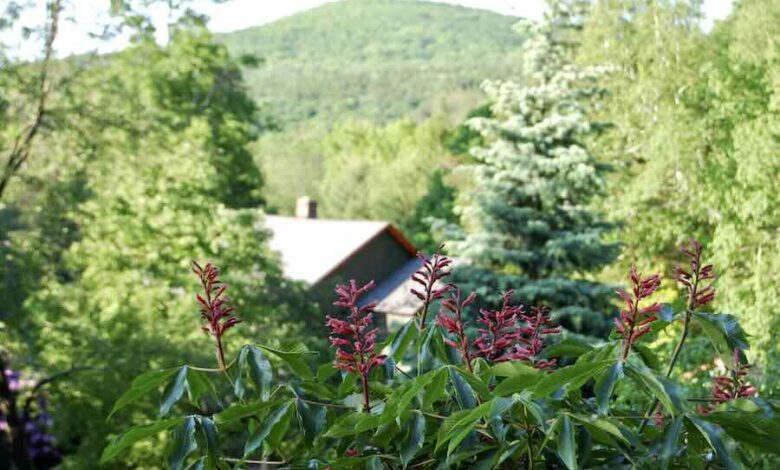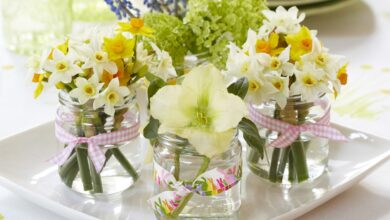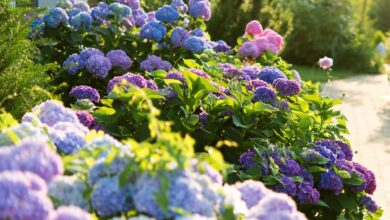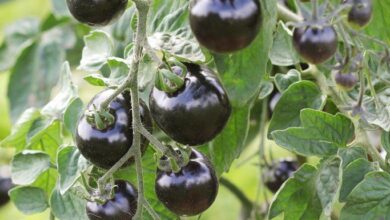
lost, but not forgotten: plants we once loved, with ken druse
[ad_1]

There are losses every year, no matter how expert you are, but some of them really stand out in memory, indelible.
Plants we have loved and lost, but never forgotten (like my Aesculus pavia or red buckeye, above): That’s our topic this time, with my friend, Ken Druse. You all know Ken, who gardens in New Jersey and is the author of an impressive 20 garden books.
Read along as you listen to the July 24, 2023 edition of my public-radio show and podcast using the player below. You can subscribe to all future editions on Apple Podcasts (iTunes) or Spotify or Stitcher (and browse my archive of podcasts here).
 plants we’ve lost (and miss), with ken druse
plants we’ve lost (and miss), with ken druse
Margaret Roach: Hi, Ken. Lost anything lately [laughter]? I had to ask.
Ken Druse: You proposed this as an idea about a week ago, and I could hardly remember the ones that are missing.
Margaret: I know.
Ken: I mean, I can remember the special ones. Conservatively, I’ve lost 50 percent of the herbaceous plants, usually in the first year. But I think it’s much more than that. I look at pictures from 15 years ago, I don’t even know what those plants are.
Margaret: You said I brought this up a week or whatever ago, and the reason being that in August, you and I are going to do a free webinar about really special plants—just like a greatest hits and things we recommend for different purposes and so forth. We wanted to mention that, shout that out.
But in the process of figuring out that webinar and the curriculum, so to speak, for that webinar, we ended up finding ourselves talking a little bit about, “Oh yeah, remember that such-and-such?” [Laughter.]
Here we are with a little teaser. Should we complain first for 30 seconds about the weather? How many inches of rain have you had in the last week? I’ve had 5.2.
Ken: I’m very close to that. But the heat, and now mosquitoes, which we rarely have mosquitoes here. We have mosquitoes like a commercial for OFF! when they used to show the guy’s arm going in a box. That’s what it’s like. It’s incredible.
Margaret: We’re lucky, because neither one of us at the moment has damaging flood or damage to our houses or anything like that. But it’s very dramatic, very terrifying, and reading the headlines is even more terrifying. A shout-out to all of you who are trying to farm or have had damage or whatever.
Ken: Not to mention orange sky before that.
Margaret: Smoke gets in your eyes, right? Yeah.
So: Plants that have gone before. You know I love music [laughter]. I get lyrics stuck in my head, and I have one of those people with the earworm problem of a tune going through my head all the time. This topic reminds me, I have to tell you, Ken, of a Willie Nelson-Julio Iglesias duet. I don’t know if you remember it, “To All The Girls I’ve Loved Before.”
“To all the girls I’ve loved before/who traveled in and out my door/I’m glad they came along/I dedicate this song/to all the girls I’ve loved before.”
But that’s kind of like what was on my mind when I brought this up to you. Who have you loved and lost? Who do you want to shout out first?
Ken: Well, I guess to let me a little bit off the hook, I’m going to shout out first some plants that it wasn’t my fault [laughter]. It’s probably never my fault.
Margaret: O.K. Who are we going to scapegoat for this?

Margaret: Wow. Yeah.
Ken: I have so much trouble doing that, arboricide.
Margaret: Letting go?
Ken: Or murdering. Yeah, letting go.
Margaret: Taking it and saying, “O.K., I give up. I admit defeat. This is a lost. I’ve lost this individual.”
Ken: Especially when it’s over 100 years old. Although I can weed, but that’s about it [laughter]. I can move a plant if necessary.
Margaret: I was at a friend’s garden the other day and he asked me to come over and look at an old contorted hazel or filbert, whatever we call it, European hazelnut or filbert. Corylus…what is it… avellana ‘Contorta,’ I think, you say?
Ken: Right. Harry Lauder’s walking stick.
Margaret: Exactly. He had this really old… I mean, when I say really old, I think it was 25 years old and it hadn’t leafed out well this year. He wondered if it was the spongy moths. I said, “No. It’s not that it’s been defoliated, it’s that it didn’t leaf out.” I looked closely and I said, “I think it’s a goner. I think it’s almost done.”
He was just like, “Aaaah,” because it’s just this sculpture, because it’s so old, it’s amazing. Fortunately, that one will not have to be taken down right away, but could probably be a handsome sculpture for quite a number of years.
Ken: For Clematis to grow on or something.
Margaret: Exactly. Exactly. Anyway, but yeah.
Ken: They do have a problem currently. The Corylus have some kind of disease.
Margaret: Yes, they do. There’s certain varieties that are more resistant than others and so forth.
Ken: But sometimes it’s aesthetic and I know I should do it. I remember when we first moved here, John Trexler came and looked at all the woody plants, the late John Trexler, who was a woody plant expert. There was a blue spruce that had hardly any branch except at the top, and it was very tall. John said, “You should get rid of that.” I wouldn’t hear of it for over 20 years when it finally didn’t have any branches. It really was an eyesore, and a big problem visually and design wise in the garden. He was right from the start.
Margaret: Normally what the common name that people use for blue spruces is they say Colorado blue spruce. That’s one of the common names for it. The Colorado gives you a hint about that plant, which is that it’s a plant that grows in a mountain environment. It’s an upper elevation… Not at the very top of mountains, but you know what I mean. However many generations ago we turned it into a cultivated plant, or tried to turn it into a cooperative cultivated plant, because it’s pretty fast-growing, it’s attractive. it gives you a lot of oomph in your garden.
We started using it all over in a lot of regions of the country, except its lifespan outside its natural environment is, if you’re lucky, 20, 25, maybe 30 years, but not really. You outgrow it if you stay in your house for your whole adult life. A lot of times it’s not even like you were talking about a pest that came and got your ash. Sometimes it’s just that we really shouldn’t be trying to grow some of these plants the way we’re trying to grow them, right?
Ken: Sometimes it’s the soil, the alkalinity or the acidity, wrong place. Sometimes it’s shade, often it’s shade. And sometimes it’s because of I guess I could say optimism [laughter]. When somebody says, a grower says Zone 7A, and I think, ooh, that’s almost the same as 6B or 6A. Maybe even it’s there for three years before the cold finally gets it. But now with the blue spruce, the way things get so much hotter here than they did 25 years ago.
Margaret: It’s accelerating what I was just talking about. I was talking to some plant pathologists from Purdue recently, Purdue University in the Midwest, and they were saying it’s just people still come into garden centers asking for it, but good garden centers shouldn’t sell it and don’t sell it because they know that it’s not really right for that climate or the Northeast or whatever.
Ken: Around here, they sell it as a shrub about a foot tall.
Margaret: Right.
Ken: And then it becomes a giant tree.
Margaret: But it’s fine if you say, hey, this is a short-lived kind of thing.
Anyway, all right, so you lost an ash recently. I’m trying to think if I lost something recently. I was thinking more back to some… I mean, I remember watching in horror, it was my first close personal experience with the yellow-bellied sapsucker woodpecker, which is a native woodpecker and a wonderful bird and everything, and has this very methodical, very grid-like geometric pattern of drilling into thin-barked plants.
Among ornamentals, it loves magnolias. It made mincemeat out of a yellow magnolia. Speaking of bark, I had this pine, a Chinese pine species, Pinus bungeana. What do they call it? I can’t remember the something-bark pine. Anyway.
Ken: Lacebark?

I would love to have that plant because it was not only four-season for its coniferous foliage, but it was four-season for its beautiful trunk. It was just a wonderful plant, Pinus bungeana. Like you said, lacebark pine. But I don’t dare. I just don’t dare. But that’s one that I recommend to people. [Lacebark pine, above, at Brooklyn Botanic Garden; photo from Wikimedia Commons.]
Ken: Did it die or did it snap or something?
Margaret: No, it just got more and more…
Ken: It bled to death.
Margaret: Yeah, it really almost did. It just got weaker and weaker. It really depends. I have a magnolia on the other side of the house, a very old magnolia, that was already old when the yellow-bellied sapsuckers started being as interested in my place [laughter] as they are. It’s got lots of sap wells in it and it’s totally fine. It’s a Loebner hybrid, ‘Ballerina,’ is the name of it, a hybrid early flowering white magnolia.
It’s funny to look at it especially in the winter because all you see is the sap wells, the grids of sap wells on the trunk [laughter], but the bird never kills it because I think it was far enough along and well-enough established. I think maybe sometimes if they get to the plant early enough, like with that Pinus bungeana, it never had a chance to really…
Ken: Outgrow the damage.
Margaret: Yeah, I think so. I think so. That was a great plant though. Highly recommend it.
Ken: I love that plant. There’s one at Wave Hill that is spectacular that you’ve probably seen. One year somebody carved a heart in the bark and it was somebody loved somebody. I was so outraged. But three years later, it had healed completely so that you couldn’t see it, which is funny. Because if you do that to a beech tree, it’s there forever. But the lacebark actually healed over. Yours was too young, too thin.
Margaret: Yeah, to really tolerate it.

She was actually drowning this plant. We had seven hemlocks on this property when we came here. We only have one now. There was a gigantic one [below] that had been attacked by woolly adelgid. It was kind of weak. And then in that same hurricane, when it was under 4 feet of water just for a couple of days, that’s all it took, because hemlocks, too, have very shallow roots, and they need air. You don’t think about trees needing air. You think about them needing water, of course, but they do need oxygen at the roots.

One of the ones that they love to espalier—which I hadn’t seen done, but I mean, I guess it’s obvious—is things like ‘Forest Pansy,’ the dark-leafed Eastern redbuds. They cut out a lot of the branches and make a fan kind of thing. It’s just really dramatic with those beautiful, what are they, heart-shaped, would you say, the leaves. They’re beautiful. There’s one that’s a tricolor leaf. Have you seen that one, ‘Carolina Sweetheart’?
Ken: Oh, is that the one that’s yellow and orange?
Margaret: There’s a sunset-y looking one, too, but there’s one with pink in it as well, pink and purple. Oh my goodness, it’s gorgeous.
Ken: There’s too many. I have ‘Silver Cloud.’ I don’t know if you’ve ever seen that.
Margaret: No. No.
Ken: That has almost pure white foliage with little touches of pink. I thought that’s going to get damaged in the sun. I planted it in the shade, and it really limped along for about three years. I was in North Carolina and I saw that tree growing in a lawn in North Carolina and it’s full sun. I dug it up and moved it to a sunnier spot and it’s fantastic. It doesn’t burn.
Margaret: The redbuds are great, and some of the cultivars with the colorful leaves give you a little extra oomph as far as the…
Ken: And there are weeping ones. It’s funny how that happens.
Margaret: What else? Any other ones that you want to shout out that you still remember from-

Margaret: Because she’s an idiot. My friend Margaret, she’s like such an idiot. It’s unbelievable [laughter].
Ken: I think the next year it had so many flowers. Sometimes when a plant makes a lot of fruit or a lot of flowers, it’s kind of like a last-gasp. That was one year it had a lot of flowers, and the next year the branches started to die back. And then the next year it died. I’d had it for long enough that it had the wonderful bark. Talk about camouflage, the bark was beautiful. This tree was so gorgeous and it died.
Margaret: As you said, Cornus florida, the native flowering dogwood, is prone to anthracnose in particular in our climate, in the Northeast and in places where there’s humid conditions that promote it. Most of the kousas are not, but ‘Wolf Eyes,’ and there’s like three I think that are especially prone to it.
Ken: Now you tell me.
Margaret: I think ‘Autumn Rose,’ ‘Moonbeam,’ and ‘Wolf Eyes’ or something. I had read that because I had had the plant, thinking the same thing, years before and had the same experience where it declined with anthracnose.
Ken: I got it at the Trade Secrets plant sale years and years and year ago.
Margaret: The plant sale in Connecticut. Right, right, right. I love the Cornus kousas. I only have two, but I would be heartbroken if I lost them, because they are so floriferous, right? I mean, they’re so showy.
Ken: Later than the floridas. The Cornus florida is over. And then in between are these wonderful Rutgers hybrids that so far, knock wood, knock dogwood, don’t get diseases, and they’re pretty fast-growing. We have ‘Stellar Pink,’ I think it’s called, and ‘Celestial Shadow.’ Mostly they have Rutgers names because they’re from Rutgers.
Margaret: Rutgers University, the breeding program.
Ken: But they take the best of both species.
Margaret: One plant I really miss, one woody plant I really miss that I had for so many years, and it was kind of a rarity, a real oddity when I first got it, and I don’t even remember, I got a tiny little plant from somewhere, maybe it was from Forest Farm Nursery by mail order out West or something like that, Aesculus pavia, the red buckeye [above, and top of page]. It’s kind of like a big shrub, small tree type of a creature. Maybe you can get to 20 feet technically, but I haven’t seen that too often. It’s like Southeastern, down into Florida, like North Carolina down to Florida native, I mean. Its range goes over to like in the middle of Texas and over to Illinois.
So it’s not native here, but it’s a Native American plant to those places that I just mentioned. It has these incredible panicles, these stems with flowers coming off them in all directions—if you know any of the Aesculus, you know that look—of deep red. They’re just incredible plants. I love that little tree. It just went kaboom, goodbye. It didn’t decline. It just croaked. And that was my experience.
That’s one I’d like to have again, and I don’t know why I haven’t made room to put another one in somewhere. But that reminds me, that same experience was what was probably, gosh, one of my most beloved of all that I had for many, many years, a Korean maple, not a Japanese maple, but a Korean maple, Acer pseudosieboldianum. It was right when you came into the place. You opened the gate and you came in the driveway. It was right there on your right, this big statement.
It was nice bare. It was like a Japanese-mapley look bare, but it was especially beautiful in leaf. The fall color [below] was unrivaled by anything I’ve ever seen, as Japanese maples also tend to be. One year, maybe five, six, seven years ago, it was perfectly fine. It got its great fall color, etc. It went to sleep for the winter and it never woke up.
Those are the ones that not only make me sad, but unhinge me in the way that that’s probably a soil-borne thing like Verticillium or something, something in the soil. It’s just mysterious. The trickiest part then is you can’t go buy another one and stick it in that hole. You couldn’t risk it.

Margaret: Another plant pathologist told me, actually someone else at Purdue told me not long ago, if you see one of those sudden-death things with the woody plant and you suspect it might be Verticillium, plant an eggplant there [laughter].
Ken: You mean as a test case?
Margaret: Yes, because eggplants are extremely susceptible to Verticillium wilt and use that as your test. Now, you can obviously send plant samples to the pathology lab and so forth, but isn’t that funny? The eggplant test [laughter]. Any others do you want to share?
Ken: The nicest Aesculus pavia, which is one of the parents of the red horse-chestnut, that I ever saw was in Virginia at Williamsburg. They had beautiful ones. But we’ve had one here for years. It’s quite small, but it blooms.
But I was thinking with the Cercis, for example, the redbuds, they grow from Texas into Canada. Not the same; there’s more than one species. But that one species, canadensis, does grow all along the East Coast. Sometimes you have to think where did this ‘Forest Pansy’ originate?
Margaret: This individual, the genetics of this individual.
Ken: Even though we’re buying it, or this variety.
Margaret: What ecotype within that? You know what I mean?
Ken: Right. That’s why maybe if it came from the mountains, it needed to grow on rock or alkaline or something. That’s one way. Now we’re talking about tree forensics and garden plant forensics. What killed my plant, that wonderful poem by Geoffrey Charlesworth.

Ken: It’s the bluest rose.
Margaret: I eventually lost that. I actually think that was when a tree fell adjacent to it and that whole area got trashed. I think that was not a disease kind of a thing. You have ‘Veilchenblau’?
Ken: Yes, in a terrible place, but it’s alive and it blooms because it’s a big plant. It can be a big plant if it’s not dead. It does have those violet flowers. I don’t think they’re fragrant, but it’s really beautiful.
Margaret: Is there another one you want to tell? I have one more that I could, but I could skip it.
Ken: No, you could, but you’re breaking my heart here [laughter].
Margaret: Oh, I’m sorry.
Ken: No, that’s O.K. I’m thinking about the hemlocks that are gone and there’s one left. The ashes, of course, and the spruces. There was Norway spruce, they’re gone; the blue spruce is gone. It’s hard to remember the ones that are gone, unless you see a stump.
Margaret: Or look at old photos sometimes. That’s what I find reminds me of something.
Ken: Yeah. I’m curious, what’s the one you were going to mention?
Margaret: Well, I was going to say, you were talking before about wet spot can kill something. Clematis really hate wet feet, especially in the winter. I had two yellow Clematis, which is not a common color in Clematis. One was tangutica. It was the variety called ‘Bill MacKenzie’ [above] in the tangutica group. It’s got almost these purple-brown centers, the stamens, or this gorgeous contrasting color to the vivid yellow, like canary yellow. It’s just a wonderful plant. I had it in a spot that I developed one of those winter wet spots of roof runoff and then a puddle. I didn’t help it. You know what I mean? I didn’t realize it was getting into a low spot for the winter, and that drowned.
The other yellow one was a paler yellow. And by the way, I could get another ‘Bill Mackenzie’ and I should, that’s available. But the other one was a paler yellow that I knew was chiisanensis ‘Lemon Bells,’ but it’s been changed. The name is now Clematis koreana or something ‘Lemon Bells’ [below]. But it was like pale yellow flushed with pink and the stems, the vine was almost like a blackish-purple. Oh my goodness, it was the most delicious, beautiful thing.
I don’t have any idea what happened to it, and that one’s really hard to get. That’s sometimes the worst thing, is when it’s almost not replaceable or you have to go down a waiting list and hope to “get one someday if you’re lucky” kind of thing.
Ken: You reminded me with the drowning and how sometimes if in a wet spot, then it turns to ice. The roots can’t take up any oxygen or anything.
Margaret: Exactly.
Ken: And it does kill it. But I grew a ‘Lady Banks’ rose, which is not hardy where I am in New Jersey, in Brooklyn. It grew up at the back of the house and it grew to almost four stories tall. People would come when it was in bloom with a thousand flowers, unfortunately not fragrant, little double butter-yellow flowers. Even Marco said, “You can’t grow that here.” They would stand there looking at that shrub and say, “You can’t grow that here.” I think Judy Zuk said that, too.
Margaret: We’re talking Marco Stufano, formerly of Wave Hill, and Judy Zuk, formerly of Brooklyn Botanic Garden. We’ve, of course, run out of time, but I’m thinking now longingly of that rose on the back of your Brooklyn home.
Ken: I’m growing the white double one now, which is great, and it’s alive.
Margaret: Good. Well, thank you for another fun conversation.
Ken: Yeah, that was something.
Margaret: See you at our free webinar that we’re going to do August 10.
Ken: Great.
register for our free ‘meet your next favorite plant’ webinar
- Registration details for the August 10 6 PM EDT free webinar titled “Meet Your Next Favorite Plant.”
prefer the podcast version of the show?

[ad_2]


 plants we’ve lost (and miss), with ken druse
plants we’ve lost (and miss), with ken druse





